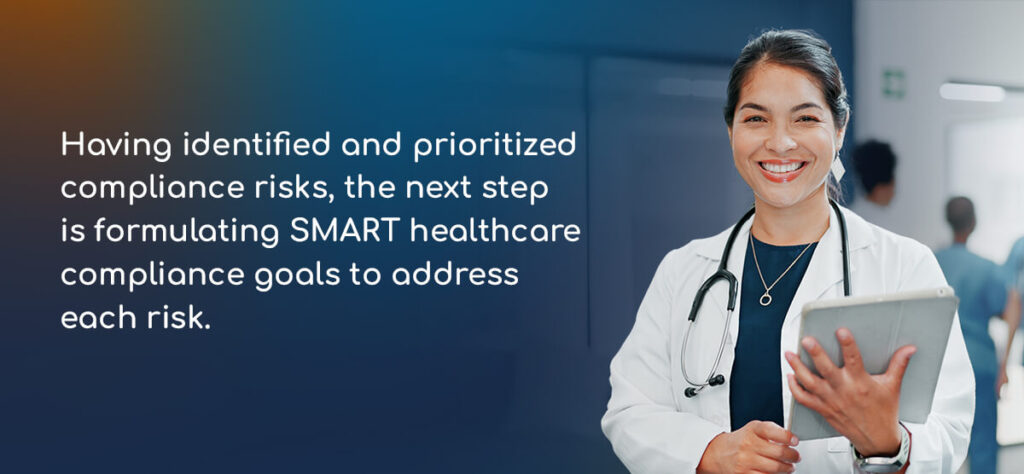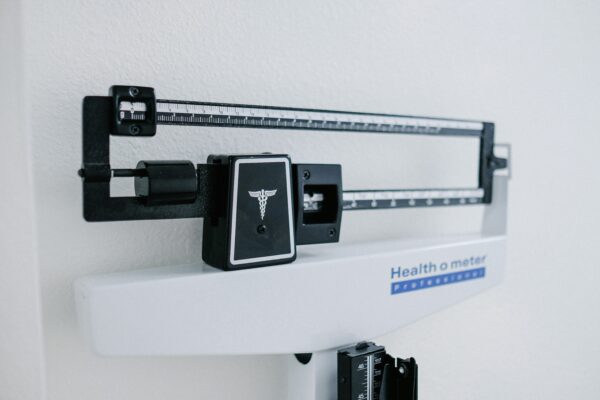Achieving and maintaining compliance supports financial stability, reputation, and quality of care. However, healthcare organizations and practices face complex, sometimes shifting regulatory environments. This presents challenges in managing an effective compliance program.
SMART healthcare compliance goals give these organizations a clear roadmap through the regulatory landscape. This guide covers the essentials of healthcare compliance planning and how to set goals for success.
What Is Healthcare Compliance Management?
Healthcare compliance management is the process of bringing and keeping an organization in line with legal, regulatory, and ethical standards. It involves anticipating, acknowledging, and addressing misalignments between the organization and the standards governing it. Various bodies can establish compliance standards for healthcare organizations, including:
- Federal, state, and local governments.
- Regulatory agencies like the Centers for Medicare & Medicaid Services (CMS).
- Accreditation bodies.
- The company’s internal leadership.
When an organization sets goals for compliance and acts to achieve them, it’s engaging in healthcare compliance management. An internal compliance committee may oversee this process, but it requires cooperation by everyone in the organization and collaboration with external entities. For example, professional compliance auditors can assist by spotting compliance risks and advising on strategies to resolve them.
What Regulations Require Compliance?
The compliance standards a healthcare organization must meet will vary based on factors like its location and the services it provides. Examples of regulatory standards affecting most healthcare organizations in the United States include:
- HIPAA: The Health Insurance Portability and Accountability Act sets national patient data security and confidentiality standards for healthcare organizations.
- CMS: CMS requires organizations caring for Medicare and Medicaid patients to follow its quality standards and billing practices.
- TJC: The Joint Commission accredits and certifies organizations meeting its patient care quality standards. These include informing patients of their rights, preventing infection, and preparing for emergencies.
3 Steps to Writing Healthcare Compliance Goals
An effective, repeatable goal-setting process is a healthcare organization’s steering mechanism to ensure compliance. The following steps are essential for formulating and achieving healthcare compliance goals.
1. Assess Compliance Risks
Before setting compliance goals, an organization must identify all applicable compliance standards and areas where it’s at risk of falling short. These could be existing compliance gaps or circumstances that could lead to a future breach. For example, if a decline in revenue raises the possibility of administrative staff cuts, the risk of failing to meet CMS billing standards would increase.
A thorough compliance risk assessment includes:
- Identifying regulations: Identify all federal, state, local, and other compliance standards the organization must meet.
- Assessing data security: Evaluate whether data storage and transmission practices conform to HIPAA’s security and privacy standards.
- Reviewing documentation: Check that all medical and financial records are accurate, complete, and compliant.
- Educating and upskilling: Ensure all employees understand their roles in upholding compliance. Provide training where necessary to meet quality standards.
- Monitoring compliance: Schedule regular internal audits to check for emerging compliance gaps. Leverage professional audits for independent insights from auditors with extensive regulatory knowledge.
- Updating procedures: Make necessary changes to internal policies and protocols. These may be to fix compliance gaps, prevent future gaps from arising, or improve efficiency in compliant procedures.
- Evaluating partnerships: Assess compliance risks associated with third-party vendors, contractors, and partners. Build compliance regulations and monitoring into partnership agreements.
- Preparing incident response protocols: Develop a detailed incident response plan to resolve breaches immediately when they arise. Include parties responsible for reporting and addressing compliance breaches in various areas.
- Documenting actions: Maintain a record of changes in response to the risk assessment. Monitor whether these are effective over time.
- Establishing improvement mechanisms: Commit to a culture of reviewing and improving practices related to compliance standards.
2. Prioritize Compliance Needs
The next step is to compare the importance and urgency of each compliance risk the assessment identifies. For example, focus on solving existing breaches first and then preventing potential ones. Using TJC’s SAFER Matrix can also help prioritize necessary improvements. This matrix asks two questions:
- How likely is the breach to harm someone?
- How extensive would the harm be?
Rate the likelihood of harm as low, moderate, or high and the scope of harm as limited, pattern, or widespread. Then, plot the likelihood on a table’s Y-axis and the scope on its X-axis. As a compliance risk score approaches the table’s upper right corner, prioritize it above risks nearer the bottom left corner.
3. Draft SMART Goals
Having identified and prioritized compliance risks, the next step is formulating SMART healthcare compliance goals to address each risk. Starting with the highest-priority needs, ensure the goals aimed at achieving them are:
- Specific: Delineate the intended outcome in clear terms, describing what the organization must do.
- Measurable: Establish metrics to support an objective assessment of when the outcome is complete.
- Achievable: Ensure the healthcare goal target is realistic, considering all resource constraints like budgets and timelines.
- Relevant: Check that achieving the stated outcome will solve or bring the organization closer to solving the associated compliance need. The goal should be compatible with all applicable standards and the organization’s values.
- Time-bound: Set a precise deadline or time period within which the organization must achieve this compliance goal.

Examples of SMART Healthcare Compliance Goals
Everyone involved in an effective healthcare compliance program will develop their ability to recognize goals that do and don’t meet the SMART criteria over time. Here are three examples of SMART compliance goals to build that pattern recognition:
- By the end of the third quarter, complete a risk assessment to check for breaches of HIPAA’s security standards and resolve the top three risks within the following month.
- By May 31, distribute an annual patient satisfaction survey based on CMS quality standards and improve the overall satisfaction score by 20% by the next year.
- This December, have 95% of staff complete a patient rights course to ensure 95% of patients receive information about their rights on their first visit by the end of next March.
Achieve Compliance Goals With DoctorsManagement, LLC
With SMART healthcare compliance goals in place, a healthcare organization can achieve and maintain compliance. However, accurate risk analysis and effective goal-setting depend on regulatory expertise. To access this expertise, partner with the compliance professionals at DoctorsManagement, LLC.
Our expert team conducts compliance audits to detect regulatory breaches and recommend actions to resolve them. A compliance audit considers HIPAA, CMS, and all other laws and standards applicable to your organization. When you choose DoctorsManagement, LCC to support your healthcare compliance program, our auditors:
- Analyze your comprehensive compliance plan to assess risks and identify gaps.
- Present their findings and recommendations.
- Provide practical training and feedback to help implement these recommendations.
With DoctorsManagement, LLC’s compliance audit services, you gain insights to shape SMART compliance goals and practical support to achieve them. Please schedule a free consultation to learn more about DoctorsManagement, LLC’s healthcare compliance services.


























